四年级下册英语教案Unit4Drawinginthepark译林版
- 格式:doc
- 大小:28.04 KB
- 文档页数:3
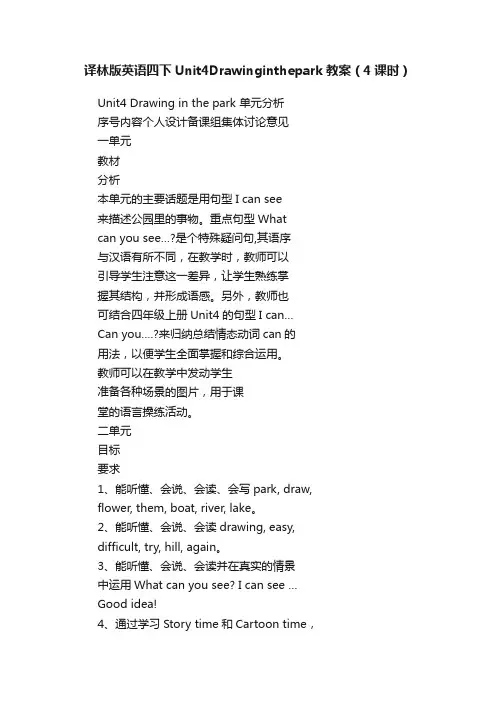
译林版英语四下Unit4Drawinginthepark教案(4课时)Unit4 Drawing in the park 单元分析序号内容个人设计备课组集体讨论意见一单元教材分析本单元的主要话题是用句型I can see来描述公园里的事物。
重点句型Whatcan you see…?是个特殊疑问句,其语序与汉语有所不同,在教学时,教师可以引导学生注意这一差异,让学生熟练掌握其结构,并形成语感。
另外,教师也可结合四年级上册Unit4的句型I can…Can you….?来归纳总结情态动词can的用法,以便学生全面掌握和综合运用。
教师可以在教学中发动学生准备各种场景的图片,用于课堂的语言操练活动。
二单元目标要求1、能听懂、会说、会读、会写park, draw,flower, them, boat, river, lake。
2、能听懂、会说、会读drawing, easy,difficult, try, hill, again。
3、能听懂、会说、会读并在真实的情景中运用What can you see? I can see …Good idea!4、通过学习Story time和Cartoon time,能比较流畅地朗读对话,并能创编对话。
5、能诵读歌谣《What can you see?》。
6、了解字母e在单词中的读音。
能运用所学的句型编新的对话。
三单元设计意图本单元的语言教学,教师可以利用图片、幻灯片、电脑课件或是电影片断,引导学生在观察中理解所学语言。
教师也可以在学完本单元之后,将学生带入实景中,看一看,说一说,以增加语言学习的真实性及趣味性。
同左小学英语4B Unit4(Period 1)教学设计方案课题:Unit4 Drawing in the park 教时:第一课时日期:月日教学目标:1、能初步听懂、会说、会读、会写park, draw, flower, them, boat, river, lake。
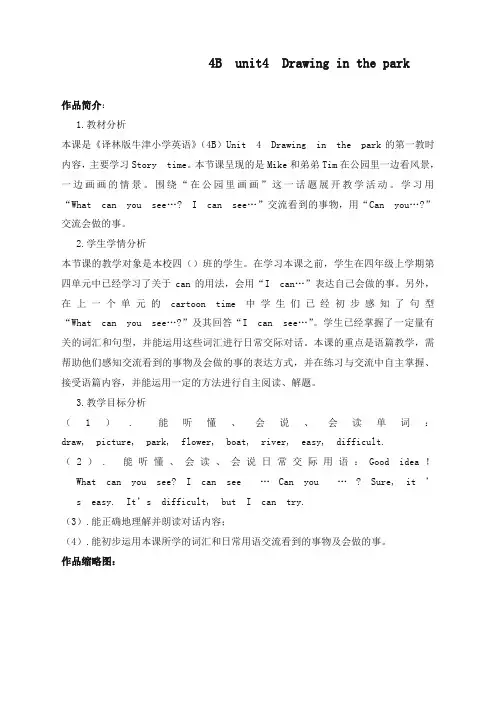
4B unit4 Drawing in the park作品简介:1.教材分析本课是《译林版牛津小学英语》(4B)Unit 4 Drawing in the park的第一教时内容,主要学习Story time。
本节课呈现的是Mike和弟弟Tim在公园里一边看风景,一边画画的情景。
围绕“在公园里画画”这一话题展开教学活动。
学习用“What can you see…? I can see…”交流看到的事物,用“Can you…?”交流会做的事。
2.学生学情分析本节课的教学对象是本校四()班的学生。
在学习本课之前,学生在四年级上学期第四单元中已经学习了关于can的用法,会用“I can…”表达自己会做的事。
另外,在上一个单元的cartoon time中学生们已经初步感知了句型“What can you see…?”及其回答“I can see…”。
学生已经掌握了一定量有关的词汇和句型,并能运用这些词汇进行日常交际对话。
本课的重点是语篇教学,需帮助他们感知交流看到的事物及会做的事的表达方式,并在练习与交流中自主掌握、接受语篇内容,并能运用一定的方法进行自主阅读、解题。
3.教学目标分析(1). 能听懂、会说、会读单词:draw, picture, park, flower, boat, river, easy, difficult.(2). 能听懂、会读、会说日常交际用语:Good idea!What can you see? I can see …Can you …? Sure, it’s easy. It’s difficult, but I can try.(3).能正确地理解并朗读对话内容;(4).能初步运用本课所学的词汇和日常用语交流看到的事物及会做的事。
作品缩略图:作品创作说明:本课通过制作PPT,以游戏,对话的的形式引导学生进行探究,然后配以讲解录音,用屏幕录像专家录屏制作,最后用格式工厂将格式转化成参赛的标准格式。

四年级下册英语教案Unit4Drawinginthepark译林版-最新教育文档Unit4 Drawing in the park (Story time)教学设计教学目标:能听懂、会读、会说单词draw picture park flower boat river easy difficult能听懂、会读、会说日常交际用语good idea , sure , it’s easy , it’s difficult , but I can try .能初步运用以下句型what can you see ? I can see ……来对看到的事物进行交流;初步使用句型Can you ……来交流会做的事。
能正确理解课文内容,并进行表演。
教学重点:句型与日常用语What can you see? I can see ... Good idea!词汇park, draw , flower , them , boat , river 教学难点:句型What can you see over there ? I can see ...词汇drawing easy difficult try 的读音教学步骤:Before- reading1.Free talk :① Daily questions②Sing a song “What can you see?”T:We can see a monkey in the tree,what can you see in the classroom?S: I can see ...(Art books )2T: You have Art lesson today.Do you like Art?S:Yes.T: Do you like drawing?S:Yes, I do .T:Can you draw ...? S: Yes , I can . T: It’s easy for you .T: Can you draw ...? S: No , I can’t . T: It’s difficult ,but you can try.3.T:It’s spring now.The trees turn green and the flowers areblooming. It’s warm and colorful.I’d like to draw spring.I’m not good at drawing ,it’s difficult for me but I’d like to try . 在黑板上画,引出词汇flower , tree , river , boat , park.While -reading1.Mike and Tim are in the park too .Look at the picture and guess “What are they going to do in the park ?”2.揭题Unit 4 Drawing in the park3.Watch and answerT:What can they see in the park ?S:They can see ...4.Read and underlineCan Tim draw the tree?Can Tim draw the flowers ?指导朗读5.Imitate ,pay attention to the pronunciation and intonation6.Read in groups7.Dub8.Summarize and fill in the blanksAfter-reading1.T:We are in a new classroom ,what can you see ?S:I can see ...T:Can you draw it / them ?S: It’s easy. / It’s difficult , but I can try .This is the ... /These are the ...T: It’s Saturday . We are in the park/in the zoo /on the farm Please talk in groups , Here are some useful sentences.What can you see?Can you draw ...?It’s easy.It’s difficult . But I can try .Well done .Can you teach me ?Ticking timeI can understand the story.I can read the story .I can act the story .课前思考这个板块的重点句型What can you see? I can see ...Good idea!在平时的英语课堂日常用语中经常会用到,学生都会用,已经对其有了语感,所以不像其余单元的重点句型一样在课堂上花很多时间去学。
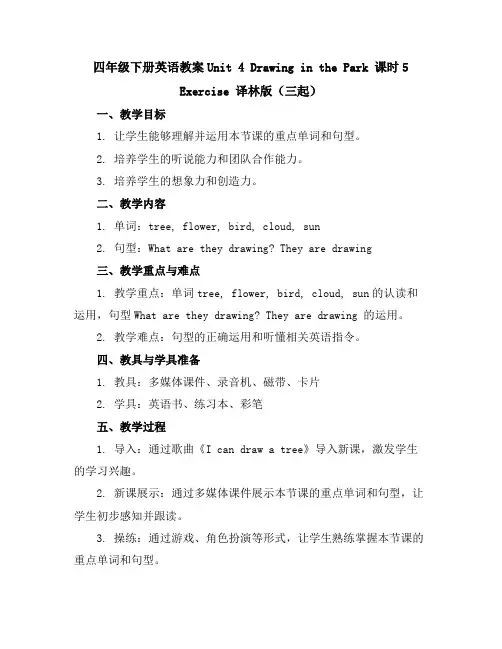
四年级下册英语教案Unit 4 Drawing in the Park 课时5Exercise 译林版(三起)一、教学目标1. 让学生能够理解并运用本节课的重点单词和句型。
2. 培养学生的听说能力和团队合作能力。
3. 培养学生的想象力和创造力。
二、教学内容1. 单词:tree, flower, bird, cloud, sun2. 句型:What are they drawing? They are drawing三、教学重点与难点1. 教学重点:单词tree, flower, bird, cloud, sun的认读和运用,句型What are they drawing? They are drawing 的运用。
2. 教学难点:句型的正确运用和听懂相关英语指令。
四、教具与学具准备1. 教具:多媒体课件、录音机、磁带、卡片2. 学具:英语书、练习本、彩笔五、教学过程1. 导入:通过歌曲《I can draw a tree》导入新课,激发学生的学习兴趣。
2. 新课展示:通过多媒体课件展示本节课的重点单词和句型,让学生初步感知并跟读。
3. 操练:通过游戏、角色扮演等形式,让学生熟练掌握本节课的重点单词和句型。
4. 应用:让学生分组进行情景模拟,运用本节课所学知识进行交流。
六、板书设计1. 单词:tree, flower, bird, cloud, sun2. 句型:What are they drawing? They are drawing七、作业设计1. 听力作业:听录音,跟读单词和句型。
2. 书面作业:抄写单词和句型,完成练习题。
3. 口语作业:与同学进行情景模拟,运用本节课所学知识进行交流。
八、课后反思1. 本节课学生的参与度较高,课堂氛围活跃。
2. 在教学过程中,要注意关注学生的学习反馈,及时调整教学方法和节奏。
3. 在今后的教学中,要注重培养学生的英语思维能力和实际运用能力。
重点关注的细节:教学过程教学过程是整个教案中最为关键的部分,它直接关系到教学目标能否实现,教学内容能否被学生有效吸收,以及教学效果的好坏。
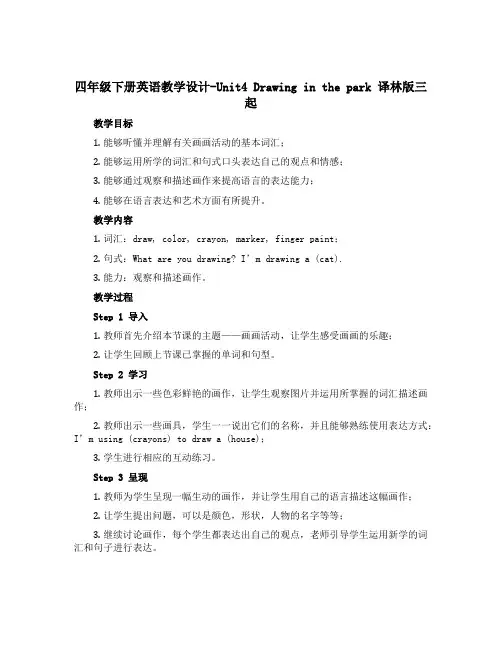
四年级下册英语教学设计-Unit4 Drawing in the park 译林版三起教学目标1.能够听懂并理解有关画画活动的基本词汇;2.能够运用所学的词汇和句式口头表达自己的观点和情感;3.能够通过观察和描述画作来提高语言的表达能力;4.能够在语言表达和艺术方面有所提升。
教学内容1.词汇:draw, color, crayon, marker, finger paint;2.句式:What are you drawing? I’m drawing a (cat).3.能力:观察和描述画作。
教学过程Step 1 导入1.教师首先介绍本节课的主题——画画活动,让学生感受画画的乐趣;2.让学生回顾上节课已掌握的单词和句型。
Step 2 学习1.教师出示一些色彩鲜艳的画作,让学生观察图片并运用所掌握的词汇描述画作;2.教师出示一些画具,学生一一说出它们的名称,并且能够熟练使用表达方式:I’m using (crayons) to draw a (house);3.学生进行相应的互动练习。
Step 3 呈现1.教师为学生呈现一幅生动的画作,并让学生用自己的语言描述这幅画作;2.让学生提出问题,可以是颜色,形状,人物的名字等等;3.继续讨论画作,每个学生都表达出自己的观点,老师引导学生运用新学的词汇和句子进行表达。
Step 4 练习1.学生进行组内交流,模拟讨论的情景,进行小组活动,互相进行讨论,并使用本次学习的句子和词汇进行表达;2.学生之间进行互动配合,拓展表达能力。
Step 5 作业1.让学生自己画一幅画,并且进行小组讨论,运用所学的单词和句型为自己的画作进行描述;2.学生提交作业,老师进行答案讲解。
Step 6 总结1.教师根据本次课学生的表现进行总结,并对错误的地方进行讲解和纠正;2.教师向学生展示一些著名的画作,鼓励学生在艺术方面进行探索与尝试;3.教师进行教学反思,并对下一次课进行准备。
教学评估1.学生能够流利地使用所学的词汇和句子进行描述画作;2.学生能够通过观察、描述画作来提高语言表达能力;3.学生能够积极参与到小组活动中,发扬个人的长处,提高团队意识和合作能力。
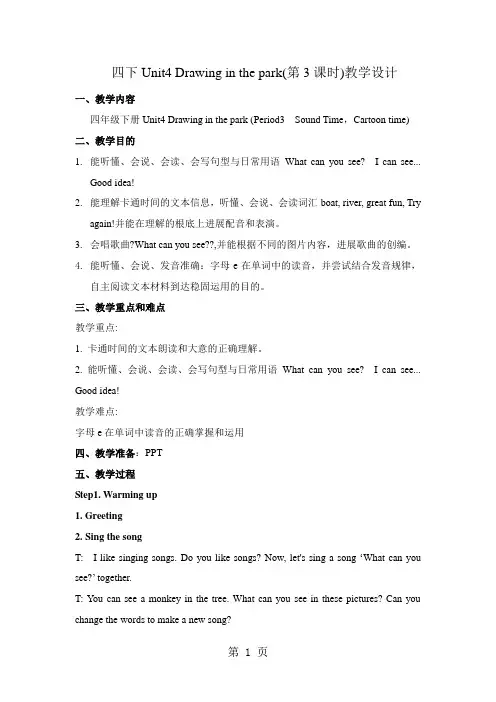
四下Unit4 Drawing in the park(第3课时)教学设计一、教学内容四年级下册Unit4 Drawing in the park (Period3 Sound Time,Cartoon time)二、教学目的1.能听懂、会说、会读、会写句型与日常用语What can you see? I can see...Good idea!2.能理解卡通时间的文本信息,听懂、会说、会读词汇boat, river, great fun, Tryagain!并能在理解的根底上进展配音和表演。
3.会唱歌曲?What can you see??,并能根据不同的图片内容,进展歌曲的创编。
4.能听懂、会说、发音准确:字母e在单词中的读音,并尝试结合发音规律,自主阅读文本材料到达稳固运用的目的。
三、教学重点和难点教学重点:1. 卡通时间的文本朗读和大意的正确理解。
2. 能听懂、会说、会读、会写句型与日常用语What can you see? I can see... Good idea!教学难点:字母e在单词中读音的正确掌握和运用四、教学准备:PPT五、教学过程Step1. Warming up1. Greeting2.Sing the songT: I like singing songs. Do you like songs? Now, let's sing a song ‘What can you see?’ together.T: You can see a monkey in the tree. What can you see in these pictures? Can you change the words to make a new song?生根据图片,交换歌词,创编新歌。
3.Review Story timeT: (呈现Story Time图片) What can you see in this picture?Can you try to ask some questions?生根据图片信息,尝试Ask and answerEg: What can they see on the river?Can Tim draw a boat? And why?4. Ss work in groups and act the story outStep2. Presentation1. Game timeT: Do you like the park in spring? It’s very nice because there are many things in the park. So the park is a kaleidoscope of colors, smells and sounds. We can also play interesting games in the park. Do you want to play? Look, I have a box here. What can you see in each picture? Let’s throw the box and have a look.T&S play the game togetherT: What can you see in the picture?S1: I can see a river. What can you see in the picture?S2: I can see a boat.T: What can you see in it?S3: I can see a kaleidoscope.复习句型What can you see? I can see...和单词flower, river,boat,lake,hill等。
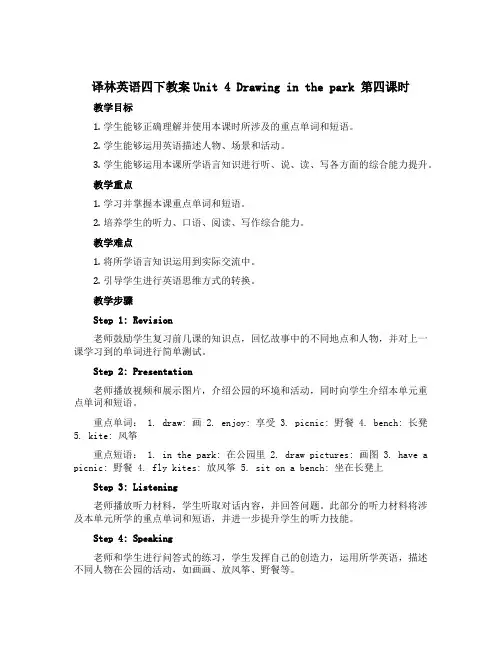
译林英语四下教案Unit 4 Drawing in the park 第四课时教学目标1.学生能够正确理解并使用本课时所涉及的重点单词和短语。
2.学生能够运用英语描述人物、场景和活动。
3.学生能够运用本课所学语言知识进行听、说、读、写各方面的综合能力提升。
教学重点1.学习并掌握本课重点单词和短语。
2.培养学生的听力、口语、阅读、写作综合能力。
教学难点1.将所学语言知识运用到实际交流中。
2.引导学生进行英语思维方式的转换。
教学步骤Step 1: Revision老师鼓励学生复习前几课的知识点,回忆故事中的不同地点和人物,并对上一课学习到的单词进行简单测试。
Step 2: Presentation老师播放视频和展示图片,介绍公园的环境和活动,同时向学生介绍本单元重点单词和短语。
重点单词: 1. draw: 画 2. enjoy: 享受 3. picnic: 野餐 4. bench: 长凳5. kite: 风筝重点短语: 1. in the park: 在公园里 2. draw pictures: 画图 3. have a picnic: 野餐 4. fly kites: 放风筝 5. sit on a bench: 坐在长凳上Step 3: Listening老师播放听力材料,学生听取对话内容,并回答问题。
此部分的听力材料将涉及本单元所学的重点单词和短语,并进一步提升学生的听力技能。
Step 4: Speaking老师和学生进行问答式的练习,学生发挥自己的创造力,运用所学英语,描述不同人物在公园的活动,如画画、放风筝、野餐等。
Step 5: Reading老师向学生展示语言材料,学生阅读教材中的短文,并把所学重点单词和短语进行整理。
Step 6: Writing老师为学生出示一些图片,让学生根据图片描述公园里正在进行的活动,鼓励学生尽可能用所学语言进行表述。
总结本单元教学目标主要是帮助学生掌握英语中日常生活用语,并为学生提供以动画形式展现的教学示范。
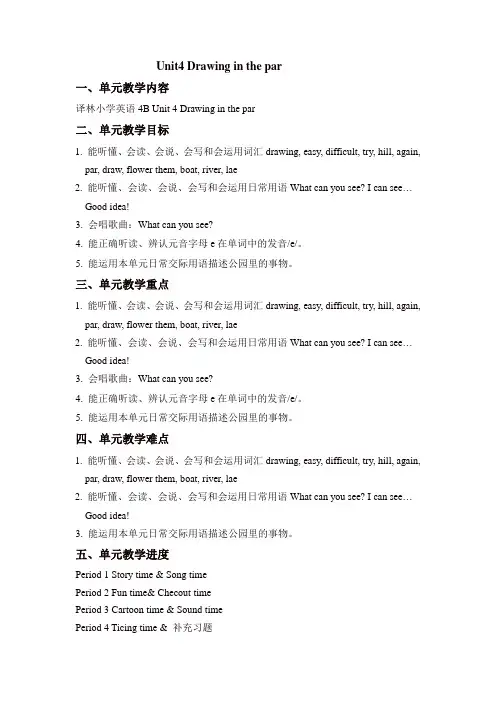
Unit4 Drawing in the par一、单元教学内容译林小学英语4B Unit 4 Drawing in the par二、单元教学目标1. 能听懂、会读、会说、会写和会运用词汇drawing, easy, difficult, try, hill, again, par, draw, flower them, boat, river, lae2. 能听懂、会读、会说、会写和会运用日常用语What can you see? I can see…Good idea!3. 会唱歌曲:What can you see?4. 能正确听读、辨认元音字母e在单词中的发音/e/。
5. 能运用本单元日常交际用语描述公园里的事物。
三、单元教学重点1. 能听懂、会读、会说、会写和会运用词汇drawing, easy, difficult, try, hill, again, par, draw, flower them, boat, river, lae2. 能听懂、会读、会说、会写和会运用日常用语What can you see? I can see…Good idea!3. 会唱歌曲:What can you see?4. 能正确听读、辨认元音字母e在单词中的发音/e/。
5. 能运用本单元日常交际用语描述公园里的事物。
四、单元教学难点1. 能听懂、会读、会说、会写和会运用词汇drawing, easy, difficult, try, hill, again, par, draw, flower them, boat, river, lae2. 能听懂、会读、会说、会写和会运用日常用语What can you see? I can see…Good idea!3. 能运用本单元日常交际用语描述公园里的事物。
五、单元教学进度Period 1 Story time & Song timePeriod 2 Fun time& Checout timePeriod 3 Cartoon time & Sound timePeriod 4 Ticing time & 补充习题Period 5 Practice 同步练习Period 1一、教学内容Unit 4 Drawing in the par (Story time & Song time)二、教学目标1. 能听懂、会说、会读单词:drawing, picture, par, flower, boat, river, easy, difficult.2. 能初步用以下句型What can you see? I can see …对看到的事物进行交流;初步用句型Can you …? 询问交流会做的事。
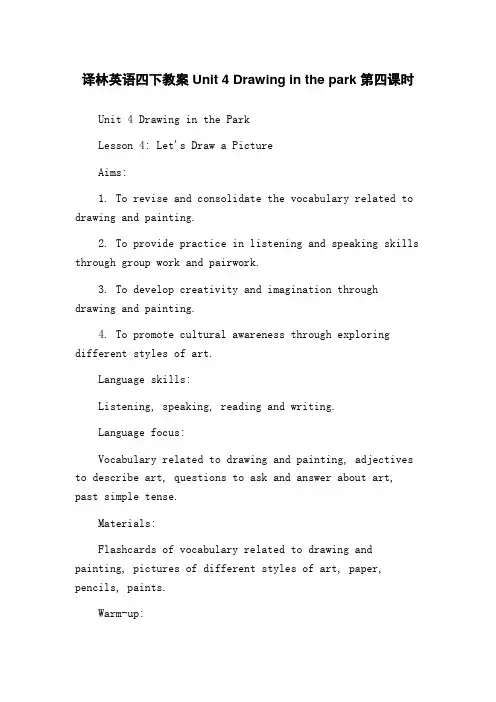
译林英语四下教案Unit 4 Drawing in the park 第四课时Unit 4 Drawing in the ParkLesson 4: Let's Draw a PictureAims:1. To revise and consolidate the vocabulary related to drawing and painting.2. To provide practice in listening and speaking skills through group work and pairwork.3. To develop creativity and imagination through drawing and painting.4. To promote cultural awareness through exploring different styles of art.Language skills:Listening, speaking, reading and writing.Language focus:Vocabulary related to drawing and painting, adjectives to describe art, questions to ask and answer about art, past simple tense.Materials:Flashcards of vocabulary related to drawing and painting, pictures of different styles of art, paper, pencils, paints.Warm-up:Ask the students if they have ever drawn or painted a picture. What did they draw? Did they enjoy it? What materials did they use? Elicit some vocabulary related to drawing and painting.Introduction:Show the students pictures of different styles of art such as impressionism, surrealism, abstract art, etc. Ask the class if they are familiar with any of these styles. Explain that different artists have different ways of creating art, and sometimes they try to challenge the way we see things.Presentation:1. Vocabulary review: Use the flashcards to revise the vocabulary related to drawing and painting. Ask the students to repeat the words after you and give examples of how to use them in a sentence.2. Listening: Play a recording of a dialogue between two students who are admiring a painting in a gallery. Ask the class to listen and answer some questions, such as \。
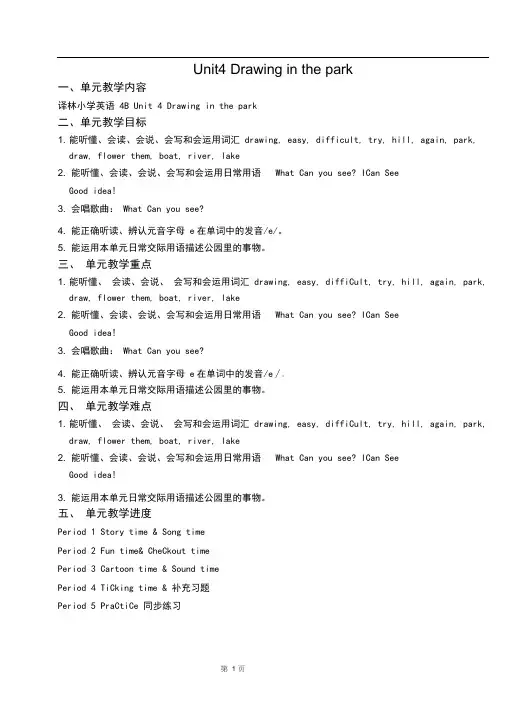
Unit4 Drawing in the park一、单元教学内容译林小学英语 4B Unit 4 Drawing in the park二、单元教学目标1. 能听懂、会读、会说、会写和会运用词汇 drawing, easy, difficult, try, hill, again, park,draw, flower them, boat, river, lake2. 能听懂、会读、会说、会写和会运用日常用语What Can you see? ICan SeeGood idea!3. 会唱歌曲: What Can you see?4. 能正确听读、辨认元音字母 e在单词中的发音/e/。
5. 能运用本单元日常交际用语描述公园里的事物。
三、单元教学重点1. 能听懂、会读、会说、会写和会运用词汇 drawing, easy, diffiCult, try, hill, again, park,draw, flower them, boat, river, lake2. 能听懂、会读、会说、会写和会运用日常用语What Can you see? ICan SeeGood idea!3. 会唱歌曲: What Can you see?4. 能正确听读、辨认元音字母 e在单词中的发音/e∕05. 能运用本单元日常交际用语描述公园里的事物。
四、单元教学难点1. 能听懂、会读、会说、会写和会运用词汇 drawing, easy, diffiCult, try, hill, again, park,draw, flower them, boat, river, lake2. 能听懂、会读、会说、会写和会运用日常用语What Can you see? ICan SeeGood idea!3. 能运用本单元日常交际用语描述公园里的事物。
五、单元教学进度Period 1 Story time & Song timePeriod 2 Fun time& CheCkout timePeriod 3 Cartoon time & Sound timePeriod 4 TiCking time & 补充习题Period 5 PraCtiCe 同步练习Period 1一、教学内容Unit 4 Drawing in the park (Story time & Song time)二、教学目标1. 能听懂、会说、会读单词:drawing, picture, park, flower, boat, river, easy, difficult.2. 能初步用以下句型 What Can you see? ICan See来对看到的事物进行交流;初步用句型Canyou…?询问交流会做的事。
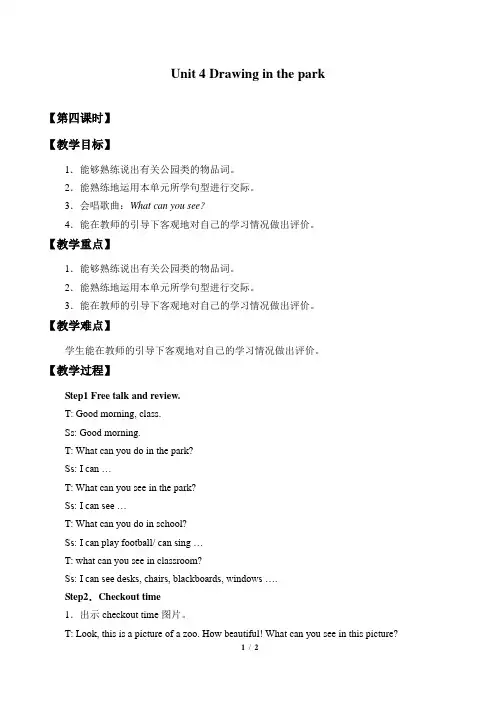
Unit 4 Drawing in the park【第四课时】【教学目标】1.能够熟练说出有关公园类的物品词。
2.能熟练地运用本单元所学句型进行交际。
3.会唱歌曲:What can you see?4.能在教师的引导下客观地对自己的学习情况做出评价。
【教学重点】1.能够熟练说出有关公园类的物品词。
2.能熟练地运用本单元所学句型进行交际。
3.能在教师的引导下客观地对自己的学习情况做出评价。
【教学难点】学生能在教师的引导下客观地对自己的学习情况做出评价。
【教学过程】Step1 Free talk and review.T: Good morning, class.Ss: Good morning.T: What can you do in the park?Ss: I can …T: What can you see in the park?Ss: I can see …T: What can you do in school?Ss: I can play football/ can sing …T: what can you see in classroom?Ss: I can see desks, chairs, blackboards, windows ….Step2.Checkout time1.出示checkout time图片。
T: Look, this is a picture of a zoo. How beautiful! What can you see in this picture?Ss: I can see…2.结合所给句型,小组内谈论图片。
Pair work. 鼓励学生使用更多的词汇讨论图片。
3.T: can you make the park more beautiful? Try to draw something on the pic.鼓励学生在图片上添加人物或物品。
译林版(三起)四年级下册英语教案: Unit4 Drawing in the park一、教学目标1.能够听懂、朗读、理解并运用单词: drawing, crayons, picture, park, tree, grass, bush, flower 等。
2.能够听懂、领会、使用句型: What are you doing? I’m drawing a picture. 等。
3.能够在图片和模仿等情境下在班内进行角色扮演,表达基本意思,学会与人沟通的能力。
4.能够在老师的带领下体验绘画过程,抽象和具体的概念;提高创造力,锻炼右脑能力。
5.能够理解和运用should/shouldn’t结构,用英语交流时养成规范的礼貌用语。
二、教学重点1.学习单词:drawing, crayons, picture, park, tree, grass, bush, flower 等。
2.学习句型:What are you doing? I’m drawing a picture. 等。
3.学习沟通技巧:在班内表达基本意思,学会与人沟通的能力。
三、教学难点1.如何运用should/sho uldn’t结构,用英语规范礼貌用语。
2.如何提高创造力,锻炼右脑能力。
四、教学准备1.卡通图片2.绘画工具 (笔、本子、颜料、刷子、画板等)3.布置环境和体验过程五、教学内容1. Warming up1.与学生问好,引导学生使用简单英语问候的方式。
2.讨论students’ park may look like. 询问学生对公园的喜好及所见所闻等,鼓励使用英语表达。
2. Leading in1.以自然、流畅的方式提醒学生本节课程的主题,并出示单词图板或卡片,引导学生认识和理解新的单词和短语,例子如下:Teacher: What am I holding?Students: Colours.Teacher: And this?Students: Paper.Teacher: And this?Students: A pencil.Teacher: Right. We are going to draw pictures in the park today.3. Presentation1.展示图片,提供口语和书写的范本,并要求学生轮流描述所看到的事物。
四年级下册英语教案Unit4 Drawing in the park 译林版(三起)一、教学目标1. 知识与技能:通过本课的学习,学生能够理解并运用句型“ What are they doing? They are ”来描述人物正在进行的动作;能够正确使用单词“drawing, playing, flying, eating”等描述公园中的场景;能够听懂、会说、会读本课的词汇和句型。
2. 过程与方法:通过图片展示、情景模拟、小组合作等方式,培养学生观察、表达、合作的能力。
3. 情感态度价值观:培养学生对英语学习的兴趣,激发学生用英语进行交流的欲望,增强学生的合作意识。
二、教学内容1. 词汇:drawing, playing, flying, eating等。
2. 句型:What are they doing? They are三、教学重点与难点1. 教学重点:句型“What are they doing? They are ”的运用,词汇的掌握。
2. 教学难点:正确运用现在进行时描述正在进行的动作。
四、教具与学具准备1. 教具:PPT课件、录音机、磁带、卡片等。
2. 学具:英语课本、练习本、彩笔等。
五、教学过程1. 导入:通过歌曲“Hello, hello, how are you?”来调动学生的学习兴趣,营造英语学习的氛围。
2. 新课呈现:通过图片展示、情景模拟等方式,引导学生学习本课的词汇和句型。
3. 操练:通过大小声、开火车、角色扮演等方式,让学生充分练习本课的句型和词汇。
4. 应用:让学生分组,每组设计一个公园场景,用英语描述正在进行的动作,并进行展示。
六、板书设计1. 课题:Unit 4 Drawing in the park2. 词汇:drawing, playing, flying, eating等。
3. 句型:What are they doing? They are七、作业设计1. 听力作业:听录音,跟读课文。
四年级下册英语教案-Unit 4 Drawing in the park Period 1-译林版三起教学内容课时目标1.学生能够听懂、认读数字 1-122.学生能够配合动作,正确唱《数字歌》3.学生能够准确、流利地朗读新单词:eleven, twelve, paintbrush, draw4.学生能够理解并能够运用句型What are you doing? I’m drawing a picture. They are painting.5.学生能够描述图片中的人物及场景内容,并且询问他人正在做什么教学重点1.新单词:eleven, twelve, paintbrush, draw2.句型What are you doing? I’m drawing a picture. They are painting.教学难点1.学生能够通过简单的句子来描述图片中的场景和人物2.学生能够运用 What are you doing? 句型来主动询问他人正在做什么教学过程导入(10分钟)1.与学生问好,进行口语交流2.让学生自我介绍并介绍自己正在做的事情(例如:I’m reading a book.)3.给学生演示 What are you doing? 句型,询问学生正在做什么,引出今天的主题学习新知(20分钟)1.听单词:eleven, twelve, paintbrush, draw 的发音,并进行跟读2.通过《数字歌》来学习数字 1-12 的正确发音和顺序3.学生创造句子,运用新单词,并且与他人分享(例如:I have twelve crayons.)4.通过各种图片来学习新单词,并在图片上练习运用句型 What are you doing? I’m drawing a picture. They are painting.合作探究(20分钟)1.学生分组,在给定的图片上进行配对练习2.学生在配对练习中进行组内交流,练习用英语来描述图片及询问他人正在做什么拓展练习(15分钟)1.学生分角色进行对话,用英语来描述自己在做什么或者询问其他人正在做什么2.两个或多个学生进行绘画活动,一边绘画一边用英语进行交流作业布置(5分钟)1.准备好练习册中的 Unit 4 相关练习作业2.家长引导学生复习数字 1-12 的发音,并联系朗读《数字歌》教学反思本节课主要是让学生了解数字 1-12,以及通过图片来学习新的英语单词和句型。
Unit 4 Drawing in the park 教案一、教学目标1. 能够熟练说出有关公园类的物品词。
2. 能熟练地运用本单元所学句型进行交际。
3. 能够掌握元音字母e在单词中的读音。
二、教学重点1. 能熟练地运用本单元所学句型进行交际。
2. 学生能够掌握元音字母e在单词中的读音。
三、教学难点学生能够掌握元音字母e在开音节和闭音节单词中的不同发音。
四、教学过程Step 1. Warming up & Free talk1. Enjoy the song: Row your boat (课前就可以播放继续让学生熟悉)2. T: Life is interesting. Last lesson, we went to the park, the theatre and the Amusement park. Today, we will go to another interesting place –Zoo. Let’s go.Step 2. Checkout time and song time1. (和手偶互动)T: Look, this is a picture of a zoo. How beautiful! What can you see in this picture?K: I can see…T: Can you …? How many …can you see?K: Yes, I can. …T: Look at …K: How beautiful! ...2. 结合所给句型,谈论图片。
Pair work.教师用手偶Ken给出评价:Good job! Well done! …3. T: The picture is beautiful, bu t there is no animals. Let’s draw some animals on the grass, in the river, in the sky or …让学生拿出笔在图中添画一些动物.4. 教师在树上画一只猴子。
四年级下册英语教案Unit 4 Drawing in the park 课时1 译林三起一、教学目标1. 知识与技能目标:学生能够听懂、会说、会读本课的单词和句子,如“draw, picture, river, flower”等,并能用英语进行简单的描述。
2. 过程与方法目标:通过游戏、唱歌、角色扮演等活动,让学生在轻松愉快的氛围中学习英语,提高学生的英语听说能力和合作能力。
3. 情感态度与价值观目标:培养学生对英语学习的兴趣和自信心,激发学生的想象力和创造力,增强学生的环保意识。
二、教学内容1. 单词:draw, picture, river, flower等。
2. 句子:What are they doing? They are drawing in the park.三、教学重点与难点1. 教学重点:学生能够听懂、会说、会读本课的单词和句子,并能用英语进行简单的描述。
2. 教学难点:句型“What are they doing? They are drawingin the park.”的运用。
四、教具与学具准备1. 教具:多媒体课件、录音机、单词卡片、图片等。
2. 学具:学生用书、练习册、彩笔、画纸等。
五、教学过程1. 导入:通过歌曲《I can draw a tree》导入本课,激发学生的学习兴趣。
2. 新课呈现:利用多媒体课件展示本课的单词和句子,让学生跟读并模仿。
3. 活动练习:通过游戏、唱歌、角色扮演等活动,让学生在轻松愉快的氛围中巩固所学知识。
5. 作业布置:布置与本课内容相关的作业,巩固所学知识。
六、板书设计1. 单词:draw, picture, river, flower等。
2. 句子:What are they doing? They are drawing in the park.七、作业设计1. 听力作业:听录音,跟读课文。
2. 书面作业:抄写本课单词和句子。
3. 口头作业:用英语描述一幅画。
译林版(三起)四年级下册英语教案:Unit 4 Drawing in thepark 第三课时一、教学目标1.掌握词汇:painting, canvas, tools, draw, brush, color.2.学会描述图片。
3.培养学生的绘画兴趣和创造力。
二、教学重难点1.单词拼写和发音。
2.如何描述图片。
三、教学过程1. Revision(10 分钟)1.上一堂课所学的内容。
2. Presentation(10 分钟)1.引入图片:展示一幅绘画作品,让学生观察。
2.告诉学生这幅画是画家在公园里画的。
这是公园里的照片,画上了孩子们在公园里做的事情,如滑梯、草地和鸟儿。
3.请学生描述图画,提示学生一些问题:–What can you see in the picture?–What are the people doing?–What animals can you see?3. Practice(20 分钟)1.学生分组,每组选一张图片。
2.每组成员轮流描述图片,其他组员猜答案。
3.讲解生词:painting, canvas, tools, draw, brush, color,并让学生跟读。
4. Production(20 分钟)1.老师发放彩笔、纸,让学生绘画小作品。
2.学生可以自由发挥,画出自己喜欢的公园景象。
3.老师可以帮助学生修正画面和技巧。
4.班内评比,并分享自己的作品。
5. Summary(5 分钟)1.让学生回答问题:What have you learned today?6. Homework(5 分钟)1.让学生画一张公园景象的图片,并写一段描述。
四、教学反思这节课主要通过观看图片,学习单词、自由绘画等方法,帮助学生学会描述图片和绘画。
学生之间的互动也使得课堂更加生动有趣。
在评比和分享环节,学生的自信心和创造力也得到了培养。
虽然本节课时间较短,但通过浏览,学生都对画画有了更深的认识。
Unit4 Drawing in the park 教案
Period One:Storytime
教学目标:
1.能听懂、会读、会说单词draw picture park flower boat river easy difficult
2.能听懂、会读、会说日常交际用语good idea , sure , it’s easy , it’s difficult , but I can try .
3.能初步运用以下句型what can you see ? I can see ……来对看到的事物进行交流;初步使用句型Can you ……来交流会做的事。
4.能正确理解课文内容,并进行表演。
教学重点:
1.读准生词draw picture park flower boat river easy difficult
2.会在具体语境中使用句型good idea , sure , it’s easy , it’s
difficult , but I can try .
3.正确理解课文内容。
教学难点:
1.生词的发音
2.怎样正确使用句型进行交际。
教学过程:
Step1 warm up
1.Greetings
2.Free talk
Day,date,weather What lessons do you have this moring?
What subjects do you like?
T:I like English ,too. we can sing songs ,we can play games at an English lesson. Do you like games?
3.Play a game.
Answer questions with “yeah, yeah, yeah” or “no, no, no” quickly. Step2 Pre-reading
1. Teach: picture tree boat river flower
Way:T: I can draw pictures, too. (teach: draw pictures)
What can you draw? Where can you draw?
This is my picture. Is it beautiful? Thank you. It’s a picture of a park. (teach park)
Look at this park. What can you see?T: what can you see in the picture ?
S: I can see……(逐个教授tree boat river flower)
Step3 While reading
1.Let’s guess
(1) There are another two persons who also come to this beautiful park.
Who are they?
What are they doing in the park?
2.Watch and choose
(1)What are they doing?You can get the answers from the cartoon Let’s watch the cartoon ,OK?
(2)So Mike and Tim are drawing in the park. (reveal the title of the unit), (3)teach drawing
3.Listen and tick
What does Tim draw?
Let’s listen and find out the answers. Listen! Have you found the answers?
4.Read and judge
T: They can draw the tree,the flowers and the boat in the park .Look at these pictures, Which can be Tim’s pictures?And how do you know?
Please find the sentences in the passage , and underline it . (Teach: easy difficult)
指导阅读sure , it’s easy . It’s difficult , but I can try . Is this
a boat ?读出语气
5.retell the story(根据板书)
6.Learn a proverb
T:I think Tim is a good boy,because when he meets troubles,he doesn’t give up,he has a try. So ….
7.Try to imitate
You have known the story. It’s time for reading.Let’s read and imitate the story after please pay attention to your pronunciation and intonation. Are you ready?
Wow, you read very well.
8.Happy reading time
Now, boys and girls, it’s happy reading time. Choose the way you like to read the story. Ready, go!
Which group wants to have a try?
Wonderful, big hand for them.
Step 4: Consolidation
1.Let’s act.
Now, I think you can read the story very well. So, let’s act out the story. Please practice in groups.
OK, time is up. Here are some tips for you. When you act you can use them. Which group wants to act?
Big hand for them. Well done!
2.Let’s show
T:Tim draws in the park.Where else can you draw?
S: In the zoo/school,on the farm
T:I think you can draw well too,Now please take out your pictures.Show
it to your partners.Make up a dialogue and act it out.
Step5 homework
1.Draw a picture and try to describe your pictures to your friends. 完成你的画,并尝试向你的朋友描述你的画。
进一步通读课文,并试背。
2.Read Story time and try to recite it.
读Story time并试背。
教学反思:
本节课以“在公园画画”为主线展开教学,开始的free talk引入游戏,调动了学生的积极性,复习了Can you …?这个句型。
又从游戏中老师也会画画自然过渡到主题Drawing in the park,接着用出示教师画作的形式把学生带到真实的生活背景中,让学生在有声有色的声音感染中不知不觉学习生字单词。
然后引入课文故事的学习,阅读中我们由整体入手,为学生搭建了多层次的语言学习平台。
即先让学生观看课文动画,听录音找出Mike和Tim在公园中能画的景物,对短文有一个初步总的印象;然后细读短文,帮助学生梳理文本,并指导重点句子的朗读,体会人物的感情;接着在各种形式读完课文后设计了表演故事的活动。
最后,让学生和同伴讨论自己画的图画并编对话进行表演,让英语与美术进行了整合。
学生在整节课中很投入,积极参与课堂,无论是回答问题还是朗读表演都很不错,充分体现了学生的主体性,着实培养了学生的口语表达和运用能力。
当然,这节课中还有许多不足的地方。
比如:1.教师的教学机智还有待提高。
2.在教授新单词,tree,flowers,boat等新单词时,可以让学生上黑板画一画。
3.最后一个环节只表演了一组,时间上安排的不够合理,出现前松后紧的状况。
希望在以后的教育教学工作中能够多思考、多锻炼,争取有进步。